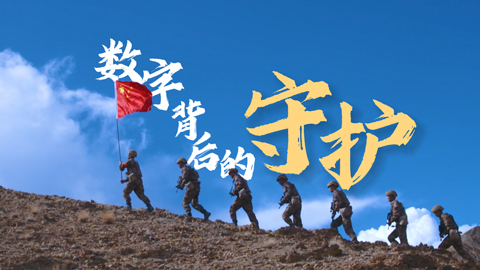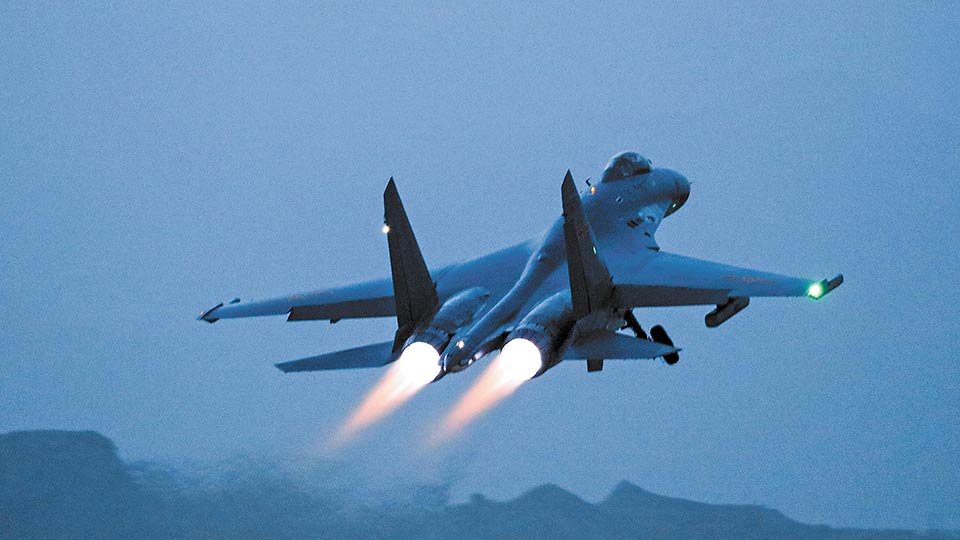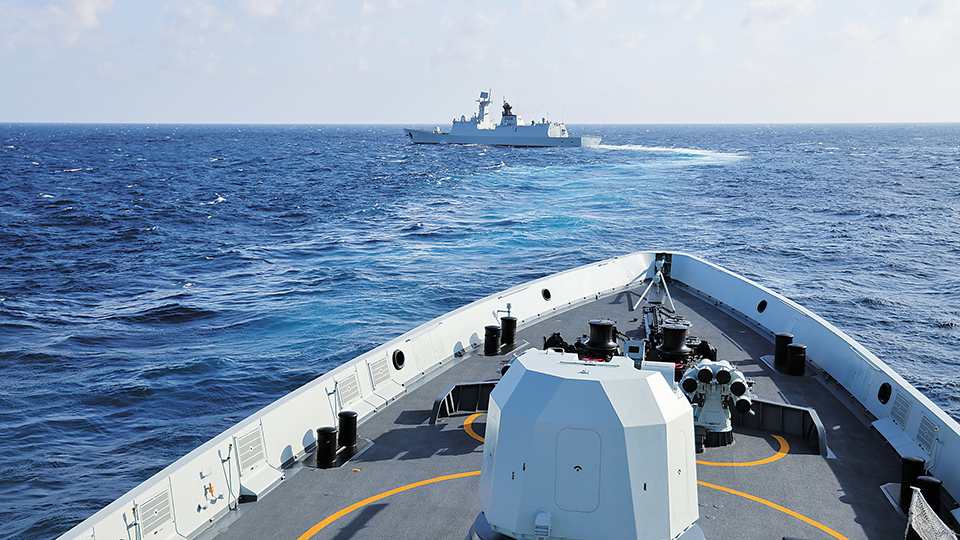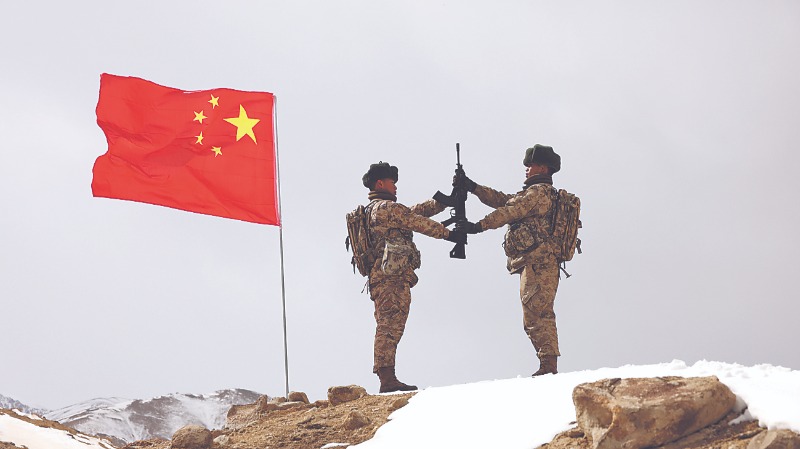
(The following English text of the press conference is for reference. In case of any divergence of interpretation, the Chinese text shall prevail.)
Question: April 23 marked the 72nd anniversary of the founding of the Chinese People's Liberation Army (PLA) Navy, and the PLA Navy (PLAN) held a series of celebrations for its 72nd birthday. Could you give us more details on that?
Answer: President Xi Jinping, also general secretary of the Communist Party of China (CPC) Central Committee and chairman of the Central Military Commission (CMC), attended the commissioning ceremony of three main battle warships of the PLA Navy and boarded the three vessels for inspection on April 23, 2021. PLA officers and soldiers were greatly inspired and invigorated. Besides, the PLAN organized a series of celebrating activities including the launch of a theme video titled "The PLAN’s Report to the CPC Flag", which fully reflects the new achievements and fresh look of the navy in its development in the new era. PLAN units carried out various celebrating activities such as flag-raising ceremonies, theme lectures, quiz on naval knowledge, visits to military history museums, reviewing the CPC membership oath, holding theatrical performances, and having full dress on warships, celebrating the Navy’s founding anniversary in the sailors’ ways. The PLAN cooperated with the Military Museum of the Chinese People’s Revolution to offer theme education and publicity activities. Pilots of carrier-based aircraft were invited by the museum to give lectures to middle school students in Beijing.
At this point, I can't help thinking of the extraordinary years when the navy was founded. In more than 100 years from 1840 to 1949, China had suffered foreign invasion from sea for more than 470 times. How to defend the coastal areas of the fledgling People’s Republic and safeguard China’s sea frontiers? The Chinese Communists led by Comrade Mao Zedong made arduous explorations into the reinforcement of coastal defenses and development of a naval force. In January 1949, the Politburo of the CPC Central Committee proposed to establish a navy capable of "defending the country's coastal and riverine areas." On April 23, the CPC Central Committee and the CMC telegraphed an order (to the Third Field Army of the PLA) to establish the navy of the PLA East China Military Command and appoint Zhang Aiping as commander and political commissar of the naval force. April 23 later became the founding day of the PLAN. On the afternoon of April 23, 1949, amidst the rumbling fire of cannons in the Crossing-the-Yangtze-River Campaign, and with only several old warships rebelled from the Kuomintang, the establishment of the navy of the PLA East China Military Command was announced at the Baima Temple in a small village in Taizhou, east China’s Jiangsu Province, where the commanding post of the Third Field Army for the Crossing-the-Yangtze-River Campaign was located.
With only 13 people at that time, the navy of the PLA East China Military Command seemed to be the smallest naval force in the world. However, they held the firm conviction that, with the 13 persons as the vanguards, a naval force consisting of 130,000 troops would surely be built. In August of the same year, Chairman Mao wrote an inscription for the navy of the East China Military Command: "We must build a navy capable of safeguarding our coastlines and effectively defending us against potential imperialist invasions." Since then, the PLAN embarked on the road of development amid great difficulties and grew up through battles. Cutting through waves and experiencing storms and wind to move forward, it has developed from scratch to possessing all the five arms with both nuclear and conventional weapons. From coastal waters to high seas, from defending sovereignty of China’s territorial waters to safeguarding world peace, the PLAN has made great accomplishments. History has proven and will continue to prove that the PLA Navy has always been an iron Great Wall at sea that defends national sovereignty, security, and development interests, and has always been a staunch force serving the building of the maritime community with a shared future.
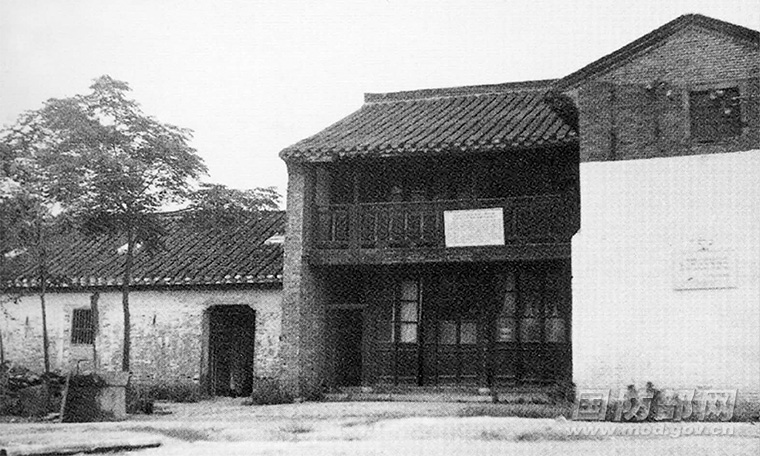
Question: During the Tomb-sweeping Day this year, officers and soldiers of the Chinese military commemorated martyrs and paid tribute to heroes in various ways. Could you please give us more details about this?
Answer: In this special year of commemorating the 100th anniversary of the founding of the CPC, PLA service members paid tribute to the martyrs and expressed their grief through various forms during the Tomb-sweeping Day. They paid homage to the martyrs' cemetery, visited revolutionary sites and held online memorial activities. The Chinese peacekeeping forces and missions overseas also held memorial activities in South Sudan, the Democratic Republic of the Congo (DRC), Lebanon, the DPRK, Tanzania, and other countries to honor their comrades who died in overseas missions.
A promising nation surely has heroes, and a promising country surely has pioneers. The Chinese nation is a nation of heroes, and the new era is an era of heroes. The heroic spirit will not be withered by freezing snow and biting frost. In this spring, we commemorate heroes, admire and care for heroes, and learn from and strive to be heroes. We know the best way to remember them is to have more heroes, and the best memorial to history is to create a history.
Question: According to media report, the Training and Administration Department of the CMC recently organized a workshop for military training supervisors. This is the first of its kind since the CMC issued a call to promote military training transformation. Please give us more details on the workshop and its features.
Answer: From March 18 to 27, the workshop for military training supervisors hired by the CMC was held in Beijing with nearly 200 participants from PLA’s theater commands, military services and arms, the People’s Armed Police Force(PAP), and relevant CMC functional organs. The workshop was designed to closely keep up with the changes of military preparedness and training tasks, concentrate efforts to solve problems in training supervision, and strive to improve the quality and efficiency of training supervision.
Following Xi Jinping Thought on Strengthening the Military and the spirit of the CMC military training conference, the workshop focused on the establishment of a new military training system to boost the transformation and development of military training through innovative supervision. There are three features. First, it highlighted the importance of learning, studying, and capability improvement. Focusing on the tasks and goals of training transformation, the participants conducted an in-depth study of laws and regulations on combat, training and supervision, learned more about the development trends of military training, academic education and military vocational education, had a good command of training supervision procedures, standards, and implementation essentials, and laid a solid capability and competence foundation for conducting law-based and scientific supervision. Secondly, it was problem-oriented. Through focusing on prominent problems in the practice of supervision, the supervisors made collective efforts to tackle key problems in combat-oriented supervision, precision supervision, joint supervision, problem rectification, and talent development, so as to continuously improve the contribution of training supervision to military preparedness. Finally, it emphasized the innovation of training supervision methods. The workshop included explanations on the latest laws and regulations and theoretical lectures. In addition, in accordance with the requirements of combat-oriented supervision, it had simulated supervision operations with typical supervision tasks. The workshop help the supervisors to have a better understanding of the laws on supervision, and have clearer ideas and stronger capabilities to improve training supervision.
Question: The "Sayan Range March" Snowfield Combat and March Competition of the International Army Games (IAG) 2021 officially ended a few days ago. Please brief us on the performance of Chinese troops.
Answer: From April 15 to 16, the “Sayan Range March” Snowfield Combat and March Competition under the framework of the IAG 2021was held at the military sports training center Ergaki in the Krasnoyarsk territory, Russia. The Chinese participating troops, composed of members selected from the 78th Group Army under the PLA Northern Theater Command, competed with their counterparts from Russia, Tajikistan, Uzbekistan, Kyrgyzstan and other countries. The Chinese team topped five events in ten individual subjects, ranking the second place on the list.
This is the first time for the Chinese military to participate in the winter event of the IAG. The Chinese participating troops overcame bad weather and unfamiliar environment to enhance the ability to perform tasks in severe cold conditions. Through mutual learning with foreign militaries, they have deepened exchanges and cooperation, and improved the level of realistic training. According to the plan, the Chinese military will host and participate in a number of events under the framework of IAG 2021 at home and abroad in late August this year.
Question: Recently, US military ships and aircraft have been frequently operating in the seas and airspace around China. In April, the guided-missile destroyer USS John S. McCain sailed through the Taiwan Strait and the Theodore Roosevelt Carrier Strike Group was operating in the South China Sea. The website of US Navy recently published photos of the commander of guided-missile destroyer USS Mustin observing the PLAN aircraft carrier Liaoning at close range, and a US sailor posted on Twitter a video of carrier-based aircraft taking off and landing on the aircraft carrier Liaoning. What's your comment?
Answer: Recently, during a regular training of the PLAN aircraft carrier Liaoning formation in relevant sea areas, the US guided-missile destroyer Mustin kept having close reconnaissance of the Chinese naval formation, which seriously obstructed regular training of the Chinese side and threatened the safety of ships and personnel of both sides. It’s of an egregious nature. The Chinese naval ships on site warned the US ship to leave. The Ministry of National Defense has lodged a solemn representation with the US side in this regard.
Since the current US administration took office, the number of activities conducted by US warships and surveillance aircraft in the sea areas around China has increased by more than 20% and 40% respectively over the same period last year. The US frequently sends ships and aircraft to conduct activities in waters and airspace around China, escalating regional militarization and threatening regional peace and stability. China is firmly opposed to that. We urge the US side to strictly restrain its troops on the ground, abide by the "Rules of Behaviour for Safety of Air and Maritime Encounters between China and the US" and "International Maritime Collision Prevention Regulations", so as to prevent the recurrence of similar dangerous incidents.
Question: According to media reports, the Biden Administration recently released the proposed federal budget for fiscal year 2022, which includes the allocation of US$715 billion to the Department of Defense. The budget also mentioned that this allocation prioritised the need to counter the threat from China as the Pentagon’s top challenge. What’s your comment?
Answer: Some people in the US government are getting really paranoid and keep playing up the so-called "China threat" and "China challenge". This reflects a mental illness. This kind of behavior will only harm others and itself and lead to a "self-fulfilling prophecy." China has no intention to threaten or challenge any country. However, if someone insisted on threatening or challenging China, we would have no choice but to fight back.
Question: On April 23, several main battle warships of the Chinese Navy were put into service. Some media analyzed that it was China's "muscle-flexing" to its neighboring countries in the South China Sea. What is your comment?
Answer: The development of weapons and equipment is a decision we have made with the whole national security and development in mind, and it is also a common practice in the world. China adheres to the path of peaceful development and firmly pursues the national defense policy which is defensive in nature and the military strategy of active defense. The commissioning of relevant warships has nothing to do with the regional situation, nor is it aimed at any specific country or target. China is committed to maintaining peace and stability in the South China Sea, and there is no change in this policy and position.
Question: From April 5 to 7, the US, Japan, India, Australia and France conducted the joint naval exercise "La Pérouse" in the Bay of Bengal. Some foreign media commented that the exercise was most probably targeted at China. But some thought otherwise. What's your comment?
Answer: We have noticed the exercise. We hope the relevant countries will do more to promote peace and stability, instead of forming cliques, showing off force and intensifying regional militarization.
We are not so concerned about the media comments you mentioned. If it is not targeted at China, we welcome; if it is targeted at China, we are not afraid.
Question: According to Taiwan media reports, targeting Chinese mainland's military aircraft, the Democratic Progressive Party (DPP) authorities have recently set up the so-called surveillance, warning and destruction zones in the "airspace over Taiwan Strait", and set a "red line" for reaction when Chinese mainland's military aircraft approach areas 30 nautical miles from Taiwan Island. Meanwhile, according to the announcement by the Guangdong Maritime Safety Administration, the PLA later conducted live-fire exercises in the waters near the Nanpeng Islands in the South China Sea from April 15 to 20. What's your comment on that?
Answer: Taiwan is an inalienable part of China. The PLA’s exercises and training near Taiwan are aimed at the provocation by the "Taiwan independence" separatist forces seeking "independence" and the interference of external forces, rather than at Taiwan compatriots. All the zones or lines set by the DPP authorities across the Taiwan Strait are totally invalid and will not shake our resolve and will to defend national sovereignty and territorial integrity. The DPP authorities’ strategy of "seeking independence by force" is but like a mantis trying to stop a chariot and will only lead to its own destruction.
Question: According to official media reports, the Liaoning aircraft carrier formation has been conducting training in waters around Taiwan recently. Could you please brief us on the training? Will such training activities be organized regularly for the aircraft carrier formation in the future?
Answer: The PLAN Liaoning aircraft carrier formation recently conducted routine drills and training in waters around Taiwan and related waters in the South China Sea, aiming to test the performance of weapons and equipment, and improve the troops’ capability to perform missions and tasks. As for the second question, I want to say that the aircraft carrier is not a "homebody", and it will be the norm for the aircraft carriers to sail far away.
Question: We have noticed that during the recent ASEAN Defense Senior Officials' Meeting Plus (ADSOM-Plus), Chinese military representatives expressed their firm support for ASEAN's centrality, and proposed that all parties should take pragmatic measures to improve the regional countries' capabilities of responding to various security challenges. Please brief us on the recent defense engagement between China and ASEAN, and comment on China-ASEAN defense relations.
Answer: China has been firmly supporting the ASEAN-centered regional defense and security mechanism. Since the outbreak of the Covid-19 pandemic, the defense departments and militaries of China and the ASEAN member states have helped each other in times of difficulty, with the defense and security cooperation constantly getting deepened and consolidated.
Recently, China has sent representatives to attend, via video, the ADSOM-Plus and the ADSOM-Plus Working Group (WG) meeting, the Medical Logistics Management in Pandemic Workshop of the ASEAN Center of Military Medicine (ACMM), as well as the expert working group meetings on military medicine, peacekeeping, maritime security, and cyber security under the ADMM-Plus mechanism. During the meetings, the Chinese representatives actively participated in discussions, and made suggestions on how to improve regional cooperation in responding to non-traditional security threats. They put forward suggestions on jointly coping with the pandemic, defending multilateralism, and working together to forge a shield for regional security and stability. These suggestions were well received by other participants. The activities achieved the goal of deepening consensus and promoting cooperation. In addition, China, as a co-chair of the Experts' Working Group on Humanitarian Mine Action, will co-host relevant activities with Cambodia this year.
This year marks the 30th anniversary of the establishment of dialogue relations between China and the ASEAN, and the future is even more promising. The Chinese military will take this opportunity to strengthen communication and practical cooperation with the defense departments and militaries of the ASEAN member states, work together to safeguard regional security and stability, and make new contributions to building a closer China-ASEAN community of shared future and building a more secure, stable, prosperous and peaceful Asia-Pacific region.
Question: According to media reports, the Chinese peacekeeping medical contingent to Mali has recently provided first aid to the wounded peacekeepers of foreign troops in an attack. Please provide more details, including the overseas work of the Chinese peacekeeping medical contingents.
Answer: On April 2, an attack by extremists on a UN camp in northeastern Mali left four Chadian peacekeepers dead and many injured. The Chinese peacekeeping medical contingent to Mali rushed to provide first aid to the eight wounded. Now, the injured are in stable condition and recovering gradually.
At present, there are four Chinese peacekeeping medical contingents with 199 members dispatched to the peacekeeping mission areas in Mali, the DRC, South Sudan and Lebanon. Since the Covid-19 outbreak, the four medical contingents have kept to their posts and performed their duties while strengthening pandemic prevention and control for their own. Since arriving at the mission areas in the second half of last year, the newly rotated Chinese peacekeeping medical troops had received and treated more than 5,000 patients and wounded personnel, carried out over 150 operations, and completed tasks such as evacuation of the wounded and the sick with high standards. Among them, the Chinese peacekeeping medical contingent to DRC undertook the task of nucleic acid testing for Covid-19 detection entrusted by the UN Peacekeeping Mission, playing an important role in pandemic prevention and control.
Where there is danger, there will be Chinese blue helmets. Guided by the vision of building a community with a shared future for mankind, the Chinese military is committed to performing peacekeeping missions with professionalism and strong capabilities, and safeguarding world peace and stability with loyalty and dedication.
Question: It is reported that the Chinese military's medical institutions at all levels are stepping up the efforts in the Covid-19 vaccination. Please brief us on the military’s epidemic prevention and control efforts and its vaccine aid to foreign countries.
Answer: At present, the Covid-19 pandemic is generally under control in China. However, the situation in the world is still severe. China is facing the pressure from the prevention of imported cases and a rebound of indigenous cases. With sporadic outbreaks occurred from time to time in China, the military cannot relax on pandemic prevention and control. In order to effectively prevent the importation and spread of Covid-19, the Chinese military is carrying out effective and orderly vaccination based on the overall national arrangement.
Since the outbreak of Covid-19 pandemic, the Chinese military, in order to implement President Xi Jinping’s commitment of making China’s Covid-19 vaccines a global public good, has provided support and assistance to the international community within its capacity on the premise of effective prevention and control in China.
With the approval of the CMC, the PLA has recently provided vaccine aid to the militaries of Pakistan, Cambodia, Mongolia, the Philippines, the Republic of Congo (Brazzaville), Equatorial Guinea, Tunisia, Sierra Leone, Sudan, Laos, Lebanon and other countries. This is an important measure taken by China to fulfill its international responsibilities and obligations, which has been highly recognized and widely welcomed by the international community. Going forward, the Chinese military will continue to join hands with its foreign counterparts to fight the pandemic and deepen practical cooperation in non-traditional security fields, with a view to making tangible contributions to the early victory over the pandemic and the building of a community of common health for mankind.
Question: The five Disciplined Services of Hong Kong performed Chinese-style marching on April 15, the first National Security Education Day in Hong Kong since the enactment of the Law of the People’s Republic of China on Safeguarding National Security in the Hong Kong Special Administrative Region (HKSAR), drawing great attention from the outside world. Is the training of the Chinese-style marching organized by the PLA Hong Kong Garrison? What are the considerations behind this?
Answer: Since December 2020, the PLA Hong Kong Garrison has been invited to organize Chinese-style marching training for the HKSAR Disciplined Services. Some best soldiers from the guard of honor of the PLA Hong Kong Garrison assisted the five Disciplined Services of the HKSAR to carry out training in four batches, including the Hong Kong Police Force, the Immigration Department, the Customs and Excise Department, the Fire Services Department and the Correctional Services Department, with good results achieved.
The Chinese-style marching training for Hong Kong’s five Disciplined Forces is conducive to strengthening national security awareness in Hong Kong community, spreading the positive energy of loving the country and Hong Kong, and enhancing people’s sense of pride in their motherland. It is a small step for the Disciplined Services, but a big step for Hong Kong towards long-term peace and stability.
Question: According to media reports, troops stationed at high altitudes can now order fresh food ingredients on an APP, and have them delivered to the high altitude areas directly from the mainland. Cloud you please brief us on more details?
Answer: The CMC Logistics Support Department, the PLA Army and relevant civilian departments have carried out pilot projects on centralized purchasing of non-staple food for troops stationed in Lhasa, Shigatse and other areas of Tibet, aiming to address the problem of fresh food supply for troops stationed at high altitudes.
Based on the reality of the troops at high altitudes, military and civilian units jointly developed an APP to cover more than 90 percent of the daily non-staple food needs of the service members. Officers and soldiers can choose a variety of non-staple food including fruits, vegetables, meat, and aquatic and dairy products by themselves. They only need to place orders and submit demands with one click, and then they can have fresh food ingredients delivered very soon. It is learned that this mode will be further expanded in the future to improve the quality and efficiency of support for frontline troops.
For a long time, border defense troops have guarded the border and defended the country faithfully. Their dedication to the country will never be forgotten, and their well-being always tugs at the heartstrings of the people.
Question: According to Indian media reports, the Indian Chief of Defense Staff stated at the 6th Raisina Dialogue that China has tried to change the status quo in eastern "Ladakh" region, and that India will stand firm on the northern borders and will not succumb to China's coercive actions. What's your comment on this?
Answer: We have noted relevant reports. The remarks by the Indian side are completely inconsistent with the facts. Regarding the situation in the western section of the China-India boundary, China has explained the facts in detail, and the blame should not be placed on China.
Recently, thanks to the joint efforts of China and India, the border defense troops of both sides have disengaged from contact in the Galawan Valley and Lake Pangong, and the situation in the border area has eased on the whole. Earlier this month, China and India held the 11th round of Corps Commander Level Meeting, exchanging views on issues of mutual concern and agreeing to continue to maintain close communication through diplomatic and military channels. China's position on the China-India border issue is consistent and clear. We hope that the Indian side will cherish the hard-won outcome, abide by the agreements of the two countries and two militaries and the consensus reached in previous talks, and work with China to safeguard peace and tranquility in the border area, so as to bring the relations between the two countries and the two militaries back to the track of healthy and stable development.
Question: On April 23, a Type 075 amphibious assault ship was commissioned to the PLA Navy. Some media commented that the commissioning of this type of warship is to make substantive preparation for "military unification" of Taiwan. What is your comment?
Answer: It is a common aspiration of all Chinese people to solve the Taiwan question and achieve the complete reunification of the motherland. Our position on Taiwan is consistent and clear. We adhere to the major principles and policies on works related to Taiwan, uphold the one-China principle and the 1992 Consensus, promote the peaceful development of cross-Straits relations and the reunification of the motherland, and also remain highly vigilant against and resolutely contain the separatist activities for "Taiwan independence". We will strive for the prospects of peaceful reunification with utmost sincerity and greatest efforts.
The "Taiwan independence" separatist forces and their actions have openly challenged the fundamental interests of the Chinese nation, gravely harmed the vital interests of compatriots on both sides of the Taiwan Strait and seriously jeopardized the peace and stability across the Taiwan Strait. We will never leave any room for any form of "Taiwan independence" separatist activities, and will always be fully prepared to deal with external interference and separatist activities for "Taiwan independence". The purpose is to promote peaceful reunification of the motherland. If the "Taiwan independence" separatist forces act willfully and even make reckless moves, we will take all necessary measures to resolutely crush their attempt for "Taiwan independence" and safeguard China’s national sovereignty and territorial integrity.






